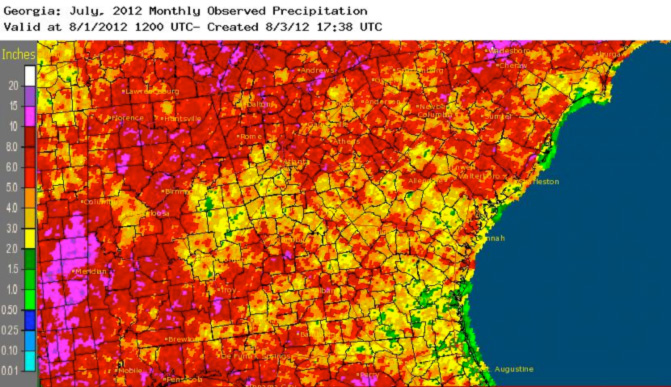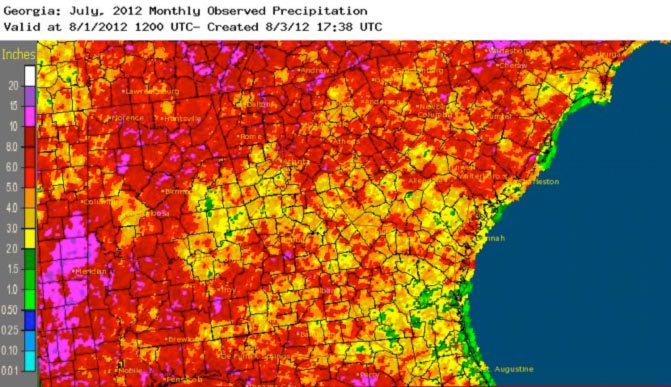Drought conditions in most parts of the state stabilized in July, although there was an increase in exceptional drought in west central Georgia due to the heat and lack of rainfall.
While the southern half of the state dried out after a wet June, northern Georgia was generally wetter than normal because of a series of thunderstorms that developed and dumped rain over the northern third of the state. In general the northern third of the state received above normal rainfall, and the rest of the state received less rainfall than normal, with the driest parts in far southeastern Georgia.
The highest monthly total precipitation from a National Weather Service station was 5.96 inches in Savannah, 0.36 inches above normal, and the lowest was in Brunswick at 1.21 inches, or 2.87 inches below normal. Augusta received 1.54 inches (2.79 inches below normal), Atlanta received 3.53 inches (1.74 below normal), Alma received 3.92 inches (1.41 below normal), Athens received 5.53 inches (1.06 above normal) and Columbus received 2.92 inches (1.84 below normal). Macon received 5.68 inches, which was .73 above normal.
The highest single-day rainfall reported by Community Collaborative Rain, Snow and Hail Network stations was 4.60 inches in northeast Georgia, north of Lexington in Oglethorpe County on July 12. The second highest daily total was 4.26 inches reported near Rabun Gap in Rabun County on July 14, with another Rabun Gap community network reporter observing 4.17 inches on the same day. The highest monthly total was 11.25 inches in Cedartown in Polk County. The second highest monthly total was 10.48 inches near Lilburn in Gwinnett County, followed closely by a 10.44 inch total in Dillard in Rabun County. Some residents northwest of Atlanta reported over 6 inches July 11-12, according to Nick Walker of the Weather Channel./p>
Severe weather was reported on 21 days in July. Thunderstorms caused mostly wind damage, although hail was reported in a few locations. Lightning from these thunderstorms caused some house fires, and the thunderstorm related winds knocked down trees and caused scattered power outages.
Despite the cooling rains in some part of the state, July saw several Georgia cities set new record high temperatures.
In Atlanta, the monthly average temperature was 83.4 degrees Fahrenheit (3.6 degrees above normal). The average temperature in July for Athens was 82.5 degrees (1.9 above normal), Columbus was 84.2 degrees(1.7 above normal), Macon was 83.4 degrees (1.6 above normal), Savannah was 83.9 degrees (1.3 above normal), Brunswick was 84.1 degrees (1.3 above normal), Alma was 82.2 degrees (0.2 above normal) and Augusta was 83.7 degrees (2.1 above normal).
It was the fifth warmest July on record for Atlanta, which has records going back for 134 years. Columbus experienced its eighth warmest July in 65 years of record, and Macon saw its tenth warmest July in 120 years of record.
July 1 was the hottest day of the month at many locations, setting records at several weather stations. Atlanta reported 105 degrees, breaking the 1954 record of 99; Athens reported 108 degrees, breaking the 1954 record of 103; and Macon recorded 108 degrees, breaking its 1954 record of 103. Augusta also broke its 1990 record of 102 degrees on July 1, recording a temperature of 104.
Atlanta and Augusta also broke record highs on July 5, with temperatures of 100 and 102 degrees respectively. On July 26 Augusta once again broke its previous daily temperature record with a high of 103, and temperatures in Alma also broke the daily record at 101 degrees.
The peach season ended in mid-July, almost three weeks early. This is the earliest it has ended in any grower’s memories, according to The Packer newspaper. Most other crops continued to be ahead of the 5-year average due to the continuation of warm conditions.








